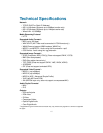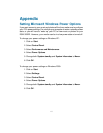115
Video
AVI: Short for Audio Video Interleave, the file format for Microsoft’s Video for
Windows standard. See under Video for Windows.
DivX: Is a video format that is MPEG-4 compliant and widely used on the
Internet for encoding video files.
MPEG: Short for Moving Picture Experts Group, and pronounced “empeg”.
MPEG generally produces better-quality video than competing formats. MPEG
achieves high compression rate by storing only the changes from one frame to
another, instead of each entire frame. MPEG uses a type of lossy compression,
since some data is removed. However, the reduction in the resulting video
quality is minimal. There are three major MPEG standards: MPEG-1, MPEG-2
and MPEG-4.
• The most common implementations of the MPEG-1 standard provide a
video resolution of 352-by-240 at 30 frames per second (fps). MPEG-1
is used with Video CDs (VCD) and results in video quality slightly below
the quality of a VCR video.
• MPEG-2 offers higher resolution with CD-quality audio. This is sufficient
for all major TV standards, including NTSC, and even HDTV. MPEG-2
is used by DVDs. MPEG-2 compresses a 2 hour video into a few
gigabytes of data on a single disc.
• MPEG-4 is a video compression standard based on MPEG-1 and
MPEG-2. Videos encoded with MPEG-4 technology are considerably
smaller than videos encoded with MPEG-1 or 2. MPEG-4 was
standardized in October 1998.
QuickTime: An audio and video compression technology developed by Apple
Computer and is widely supported on Macintosh and Windows PC computers.
The latest QuickTime implementation is MPEG-4 compliant.
XviD: XviD is an ISO MPEG-4 compliant video codec. It’s an open source
project which is developed and maintained by many people from all over the
world.
Glossary (continued)


















